Japan is a country famous for its natural beauty, and its flowers are no exception. From the delicate pink cherry blossoms to the vibrant purple wisteria, there is a wide variety of flowers to admire in Japan. Each flower has its own unique charm, and many have become symbols of Japanese culture and tradition.
Japan is known for its rich and diverse culture, and one of the most beautiful aspects of this culture is its flowers. Japan is home to a wide variety of flowers that bloom throughout the year, each with its unique beauty and significance. From the delicate sakura to the vibrant tsubaki, Japanese flowers are a true marvel of nature. In this article, we’ll take a closer look at some of the most popular Japanese flowers, when and where to see them, and their cultural significance.
Ume (Plum Blossom)
The Ume, or plum blossom, is the first flower to bloom in Japan, usually in late February or early March. The flower is a symbol of perseverance and renewal, making it a popular sight for Japanese people to visit during the cold winter months. The Ume is a small, delicate flower with shades of pink, white, and red. They bloom before the leaves come out, so they appear as small clusters of flowers on the bare branches.
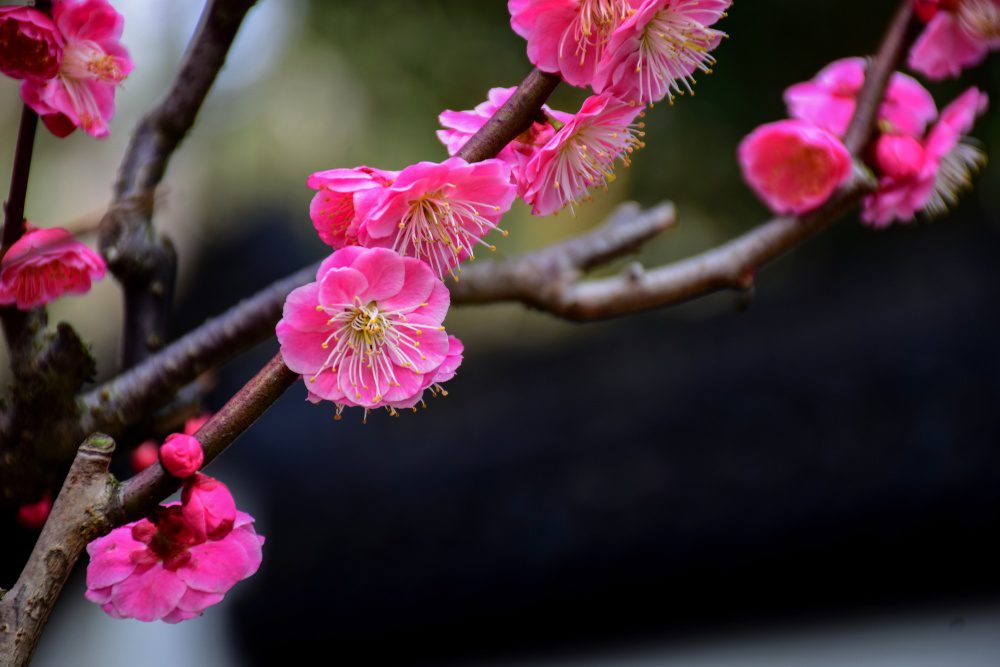
In Bloom: Late February – early March
The ume, or plum blossom, is one of the earliest signs of spring in Japan. The delicate pink and white flowers bloom in late February to early March, before the sakura. Plum blossoms are often associated with the start of a new year, as they bloom during the time of the lunar new year.
Meaning: Ume (梅) is the Japanese word for the plum blossom. It symbolizes endurance, hope, and resilience, and is associated with purity, beauty, and the arrival of spring. Ume is also used in various culinary dishes, including umeboshi, which are pickled plums with a salty and sour taste.
Where To See Them: Kairakuen Park (Mito), Yoshino Baigo (Osaka), Kitano Tenmangu Shrine (Kyoto)
Ume trees can be found throughout Japan, but some of the best places to see them include Kitano Tenmangu Shrine in Kyoto, Kairakuen Garden in Mito, and Yoshino-cho in Nara.
Best Time To See Them: Late February – early March
The best time to see ume blossoms is usually from late February to early March, depending on the location and weather conditions.
Sakura (Cherry Blossom)
The Sakura, or cherry blossom, is perhaps the most famous of all the Japanese flowers. It is a symbol of the transience of life, representing both beauty and fragility. The Sakura blooms in shades of pink and white, and the sight of the blossoms falling like snowflakes is truly breathtaking. The Sakura blooms in different parts of Japan at different times, starting from late March in the south and moving northward.
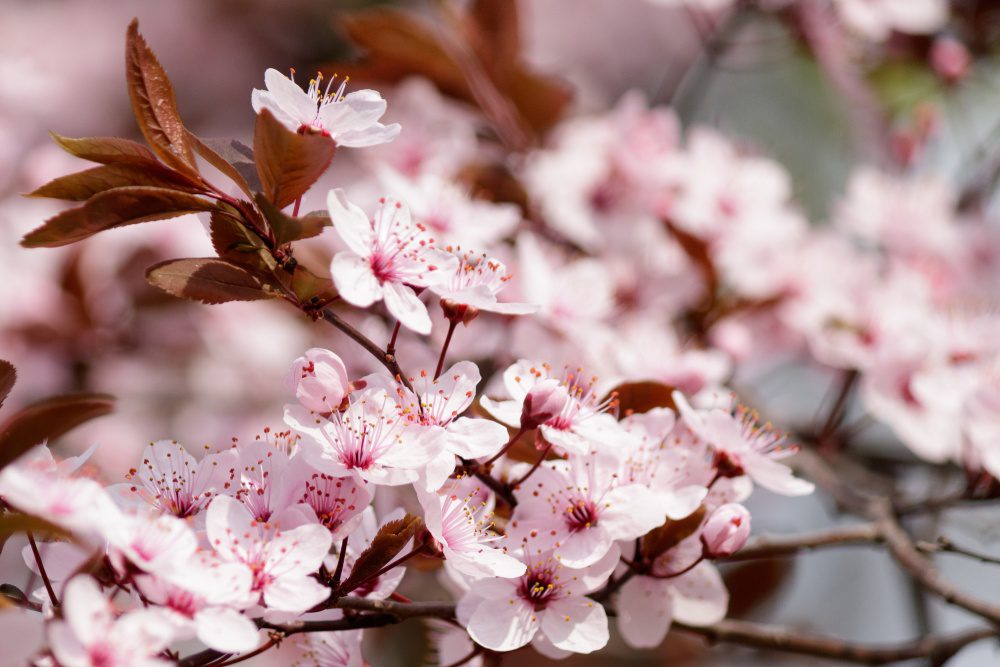
In Bloom: Late March – early May
Sakura, or cherry blossoms, are perhaps the most famous of all Japanese flowers. These delicate pink and white flowers bloom en masse in parks, gardens, and along rivers all over Japan in the springtime. The sight of the cherry blossoms in full bloom is truly breathtaking and is considered one of the most beautiful natural sights in the world.
Meaning: Sakura (桜) is the Japanese word for cherry blossom. It is a significant symbol in Japanese culture and represents the beauty and transience of life. Cherry blossoms typically bloom in the springtime and are celebrated during the annual hanami festival, where people gather to view and appreciate their beauty. The sakura is also commonly featured in Japanese art, literature, and music.
Where To See Them: Shinjuku Gyoen (Tokyo), Maruyama Park (Kyoto), Hirosaki Park (Aomori)
Cherry blossoms can be found throughout Japan, but some of the best places to see them include Ueno Park in Tokyo, Maruyama Park in Kyoto, and Hirosaki Castle Park in Aomori.
Best Time To See Them: Late March – early May
The best time to see cherry blossoms varies depending on the location and weather conditions. In most parts of Japan, the sakura usually bloom from late March to early April, but in some areas, the bloom can start as early as late January or as late as early May.
Fuji (Wisteria)
The Fuji, or wisteria, is a beautiful flower with long, hanging clusters of purple, white, or pink blooms. They are often found growing on trellises and arbors, creating stunning natural tunnels of flowers. The Fuji blooms in late April and early May, making it a popular sight for visitors during Japan’s Golden Week holidays.
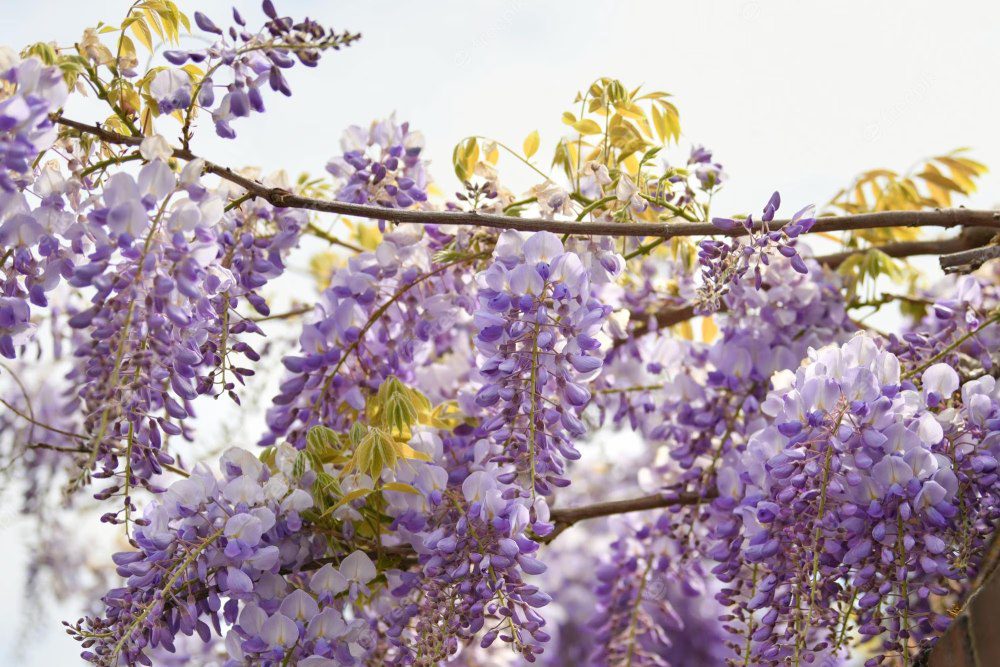
In Bloom: Late April – early May
Fuji, or wisteria, is a climbing plant that produces long, drooping clusters of flowers in shades of pink, purple, and white. The flowers are known for their beauty and their sweet fragrance, which fills the air during the blooming season.
Meaning: Fuji (藤) s the Japanese word for wisteria, a beautiful climbing plant with fragrant flowers. It symbolizes youth, love, and perseverance, and represents the transience of life as its flowers bloom for a short time each year. Fuji is also commonly trained into elaborate shapes in Japanese gardens, known as fuji musume, and is considered a refined art form.
Where To See Them: Ashikaga Flower Park (Tochigi), Kawachi Fuji Garden (Fukuoka), Kameido Tenjin Shrine (Tokyo)
Some of the best places to see wisteria in Japan include Ashikaga Flower Park in Tochigi, Kawachi Fuji Gardens in Fukuoka, and Kameido Tenjin Shrine in Tokyo.
Best Time To See Them: Late April – early May
The best time to see wisteria is usually from late April to early May, but this can vary depending on the location and weather conditions.
Ajisai (Hydrangea)
Ajisai, or hydrangea, is a popular flower in Japan that is known for its large, colorful clusters of blooms. These flowers bloom during the rainy season, typically from late May to early July, and can be found in various shades of pink, purple, blue, and white. With their striking beauty, ajisai are a favorite among nature lovers and photographers alike, and are a must-see attraction for anyone visiting Japan. In this section, we’ll explore where to see ajisai in Japan and the best time to catch them in bloom.
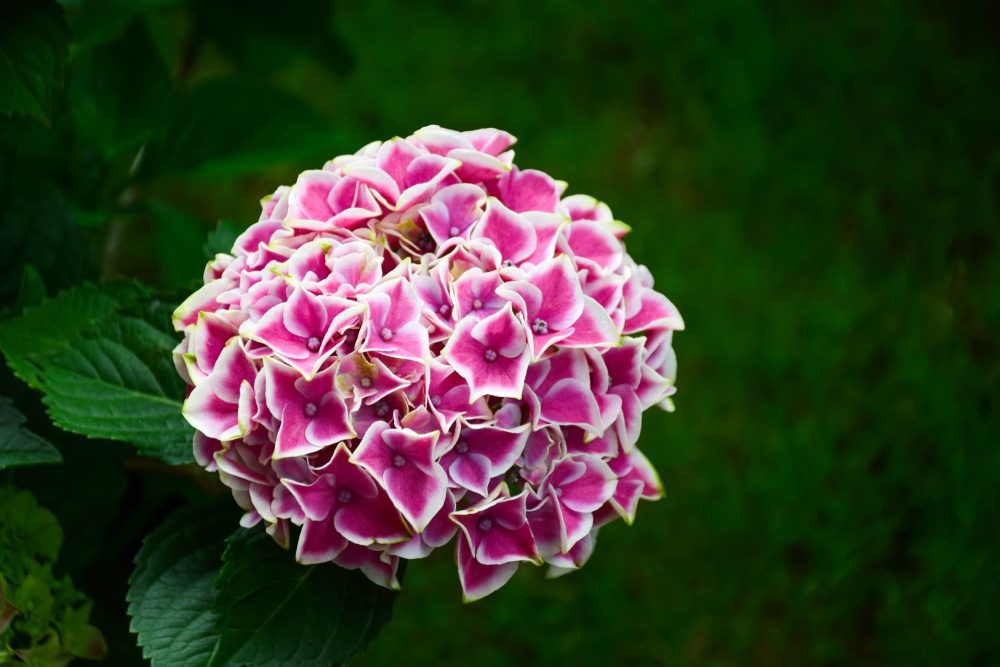
In Bloom: June – July
Ajisai, or hydrangea, is a beautiful flower that blooms in Japan during the rainy season, usually from late May to early July. It’s known for its large, colorful clusters of blooms that can range from pink, purple, blue, and white.
Meaning: Ajisai (アジサイ) is the Japanese word for hydrangea, a flowering plant that is popular in Japan and widely cultivated for its large and colorful blooms. In Japanese culture, the hydrangea is associated with gratitude, humility, and honesty. It is often given as a gift to express appreciation or to ask for forgiveness. The color of the hydrangea flowers can also carry meaning in Japan. Blue hydrangeas are often associated with the rainy season and can represent a sense of melancholy or gratitude for the rain, which is necessary for the growth of crops. Pink hydrangeas are often seen as a symbol of love and romance, while purple hydrangeas are associated with wealth and royalty. Overall, the hydrangea is a beloved flower in Japan, representing gratitude, humility, and a variety of emotions depending on its color.
Where To See Them: Meigetsuin Temple (Kamakura), Hasedera Temple (Nara), Hakusan Shrine (Niigata)
One of the best places to see ajisai in Japan is at the Meigetsuin Temple in Kamakura, located just an hour south of Tokyo. This temple is also known as the “Hydrangea Temple” and has over 2,500 hydrangea plants on its grounds. Another great spot is the Hakusan Shrine in Tokyo, which is home to a stunning hydrangea garden that is especially beautiful during the rainy season.
Other notable places to see ajisai include the Hasedera Temple in Kamakura, which boasts a beautiful hillside garden of hydrangeas, and the Mimurotoji Temple in Kyoto, which has over 10,000 hydrangea plants of different colors.
Best Time To See Them: June – July
The best time to see ajisai is during the rainy season, which usually starts in late May and ends in early July. The blooms are at their peak in mid-June, so plan your trip accordingly to catch the most vibrant display of hydrangeas.
Himawari (Sunflowers)
Himawari, or sunflowers, are a bright and cheery symbol of summer in Japan. These tall, vibrant flowers with their large golden blooms are a favorite among locals and visitors alike. Not only are they beautiful to look at, but they also have cultural significance in Japan, representing vitality, good luck, and longevity. In this section, we’ll explore where to find these stunning flowers in Japan, the best time to see them in bloom, and some tips for enjoying them to the fullest.
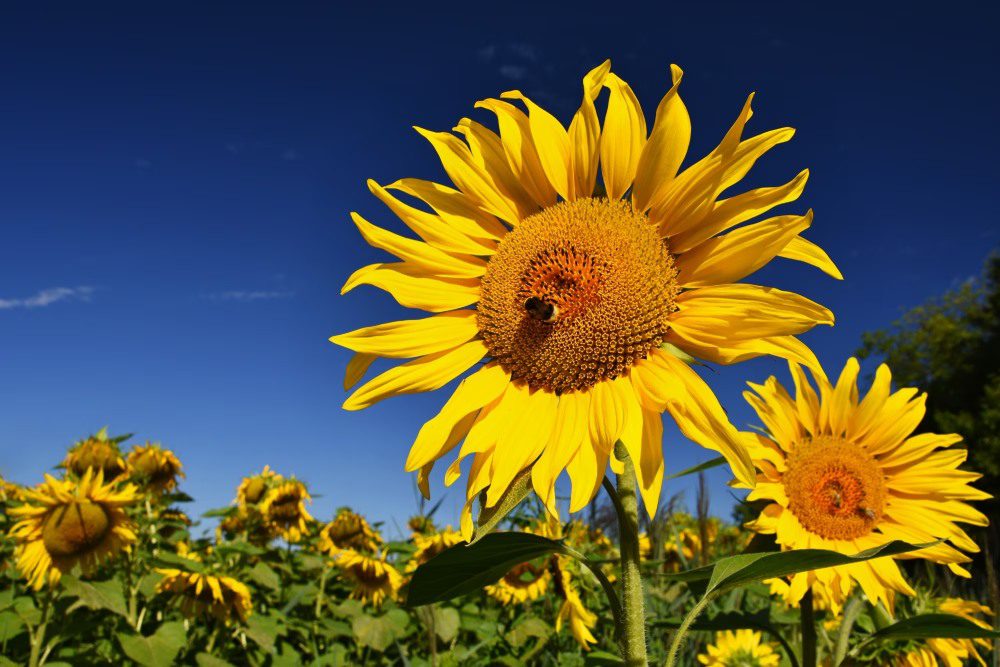
In Bloom: July – August
Himawari usually bloom in Japan from mid-July to mid-August. The exact timing can vary depending on the location and the weather conditions of each year, so it’s best to check with local resources to confirm when they are in bloom.
Meaning: Himawari (ひまわり) is the Japanese word for sunflowers, a tall plant with large yellow blooms that turn their faces towards the sun. In Japanese culture, the sunflower is associated with the sun, warmth, happiness, and longevity. Sunflowers are often given as gifts to express feelings of adoration, loyalty, and longevity. The symbolism of the sunflower in Japanese culture is closely tied to its physical characteristics, as the flower itself follows the sun as it moves across the sky, symbolizing the pursuit of positivity, growth, and progress. Overall, the sunflower is a beloved flower in Japan, representing happiness, loyalty, and longevity, and is often used to convey feelings of admiration and affection.
Where To See Them:
Sunflowers can be found in many places throughout Japan, but some of the best spots to see them are in the rural areas and farms outside of major cities. Some of the most popular locations to see sunflowers include Hokkaido, Tochigi Prefecture, and the Boso Peninsula in Chiba Prefecture. In addition, there are several farms that offer sunflower fields for visitors to enjoy.
Best Time To See Them: July – August
The best time to see sunflowers in Japan is typically in mid to late July, although this can vary depending on the location and the weather. It’s recommended to check with local resources, such as tourism websites or visitor centers, to find out the best time to see them in a specific area. Additionally, it’s important to note that sunflowers have a relatively short blooming period, so it’s best to plan a visit during the peak season to fully enjoy the beautiful blooms.
Iris (Ayame, Shobu)
Iris, also known as Ayame or Shobu in Japan, is a beautiful and elegant flower that has been appreciated for centuries. It is a popular flower in Japan and has been featured in many Japanese artworks, including paintings and textiles.
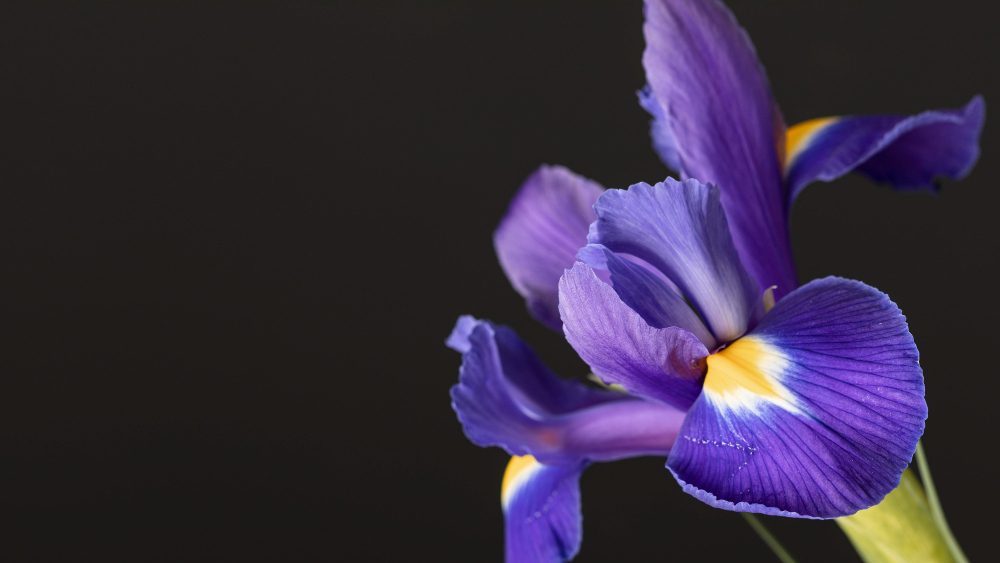
In Bloom: Late May to Early July
Iris typically bloom in Japan from late May to early July, depending on the location and the weather conditions of each year. The blooming period for the iris is relatively short, lasting only a few weeks, so it’s important to plan accordingly if you want to see them in their full glory.
Meaning:
Ayame (あやめ) is the more commonly used term for the iris in Japanese, and it is often associated with a range of meanings, including purity, elegance, and good health. In Japanese culture, the iris is also associated with the beginning of summer and is sometimes used in traditional Japanese poetry to represent the changing of the seasons.
Shobu (しょうぶ), on the other hand, refers specifically to the Japanese water iris, which is a species of iris that grows in wet environments. In Japanese culture, the water iris is associated with courage, strength, and resilience, as it is able to grow and thrive in difficult conditions. The word Shobu is also used to refer to a martial arts tournament, which is named after the iris because of its association with strength and resilience.
Where To See Them: Meiji Shrine Inner Garden in Tokyo, the Kairakuen Garden in Mito, Ibaraki Prefecture, and the Suigo Itako Iris Park in Ibaraki Prefecture
Iris can be found in many parts of Japan, but some of the most famous spots to see them include the Meiji Shrine Inner Garden in Tokyo, the Kairakuen Garden in Mito, Ibaraki Prefecture, and the Suigo Itako Iris Park in Ibaraki Prefecture. In addition, there are many smaller gardens and parks throughout Japan that have beautiful displays of iris during their blooming season.
Best Time To See Them: Late May to early July
The best time to see iris in Japan is typically from late May to early July, depending on the location and the weather. It’s important to check with local resources, such as tourism websites or visitor centers, to find out the best time to see them in a specific area. Additionally, many gardens and parks hold iris festivals during their blooming season, which can be a great way to experience the beauty of the flowers and learn more about their cultural significance in Japan.
Botan (Peony)
Botan, or peonies, are beloved flowers in Japan, with a long history of cultivation and appreciation. Known for their large, showy blooms in shades of pink, white, and red, peonies are highly valued for their beauty and symbolism in Japanese culture. In this section, we will explore the blooming season of peonies, the best places to see them, and the optimal time to witness their stunning displays.
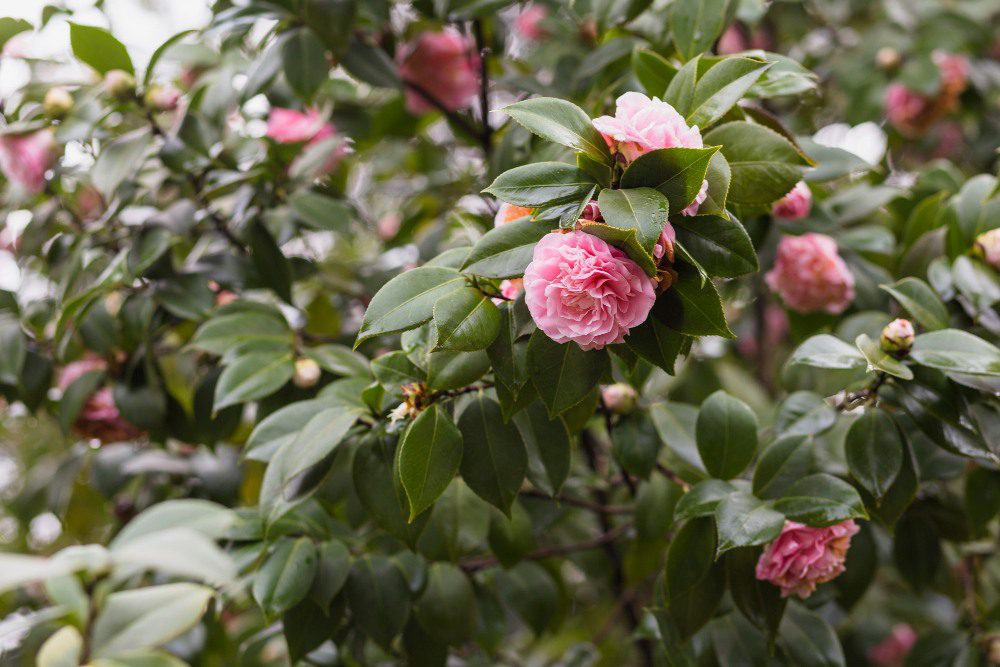
In Bloom: From mid-May to mid-June
Peonies bloom in late spring to early summer in Japan, typically from mid-May to mid-June. The blooming period varies depending on the weather conditions and the specific type of peony. Some species, such as the tree peony, bloom earlier than others.
Meaning: Botan (牡丹) means peony in Japanese and is considered the “King of Flowers” due to its beauty, elegance, and symbolism. It is associated with wealth, prosperity, and love, and is often featured in traditional Japanese art. Additionally, the peony has medicinal properties and is highly valued in traditional Chinese and Japanese medicine.
Where To See Them: Ueno Toshogu Shrine in Tokyo, Tsukuba Peony Garden in Ibaraki Prefecture, Nara Park, Bitchu Matsuyama Castle, and Himeji Castle
Peonies can be found throughout Japan, with many popular viewing spots in parks, gardens, and temples. Some of the most famous peony gardens in Japan include Ueno Toshogu Shrine in Tokyo, which has over 1,000 peony plants, and the Tsukuba Peony Garden in Ibaraki Prefecture, which boasts over 3,000 plants. Other popular locations for peony viewing include Nara Park, Bitchu Matsuyama Castle, and Himeji Castle.
Best Time To See Them: from mid-May to mid-June
The best time to see peonies in bloom is typically from mid-May to mid-June, with the exact timing varying depending on the location and weather conditions. It is best to check with the specific garden or park beforehand to ensure that the peonies are in full bloom. Many gardens also hold special events during the blooming season, such as peony festivals, where visitors can enjoy the stunning displays of these gorgeous flowers.
Tsubaki (Camellia)
Tsubaki, or Camellia, is a popular flower in Japan that blooms in late winter to early spring. It is known for its elegant beauty and is often used in traditional Japanese gardens, tea ceremonies, and festivals. The flower comes in different colors, including white, pink, and red, with each color representing a different meaning. Tsubaki is also used for medicinal purposes, with its leaves and flowers used to make tea that has several health benefits.
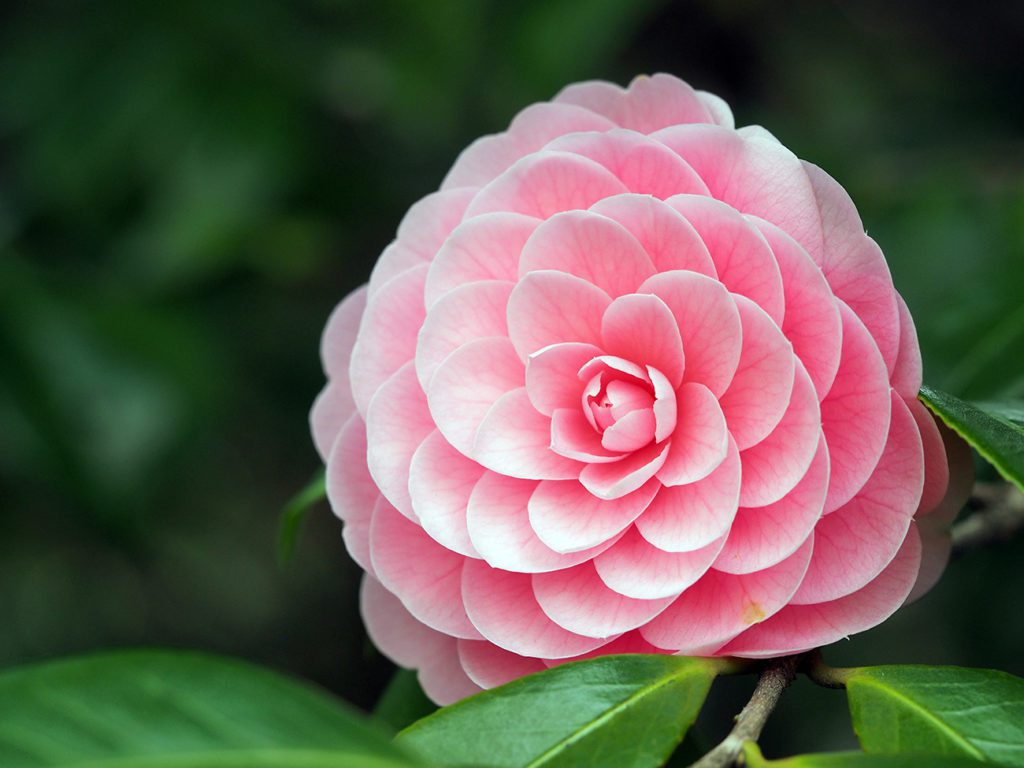
C: kcpinternational.com
In Bloom: from January to April
Tsubaki blooms from late winter to early spring, usually from January to April, depending on the region and the variety. The flowers are known for their round shape, smooth texture, and glossy leaves, which add to their elegant appearance.
Meaning: Tsubaki (椿) is the Japanese word for camellia, a flower highly prized for its beauty and symbolism. In Japanese culture, it is associated with love, admiration, and purity. The camellia has a long history in Japanese art and literature, and it has practical uses such as the production of tea oil. Its meaning varies depending on its color; red symbolizes love, white symbolizes purity, and pink represents longing. It is often given as a gift to express affection or respect during special occasions such as weddings, graduations, and funerals.
Where To See Them: Toshogu Shrine in Nikko, the Kairakuen Garden in Mito, and the Atami Camellia Garden in Atami
Tsubaki can be seen in many places throughout Japan, including public parks, gardens, and temples. Some popular places to view Tsubaki are the Toshogu Shrine in Nikko, the Kairakuen Garden in Mito, and the Atami Camellia Garden in Atami. There are also several camellia festivals held across the country during the blooming season.
Best Time To See Them: From late winter to early spring
The best time to see Tsubaki is during its blooming season, which is from late winter to early spring. The exact time may vary depending on the region and the weather conditions. It is recommended to check the local blooming forecast before planning a trip to see Tsubaki.
Tsutsuji (Azalea)
Azaleas, known as “Tsutsuji” in Japanese, are one of the most popular spring flowers in Japan. These stunning flowers come in various shades of pink, red, and white and are commonly found in parks, gardens, and temples across the country. In Japan, azaleas are not only admired for their beauty but are also considered to symbolize femininity, temperance, and elegance. With their delicate blooms and sweet fragrance, they are a must-see attraction for visitors to Japan during the spring season.
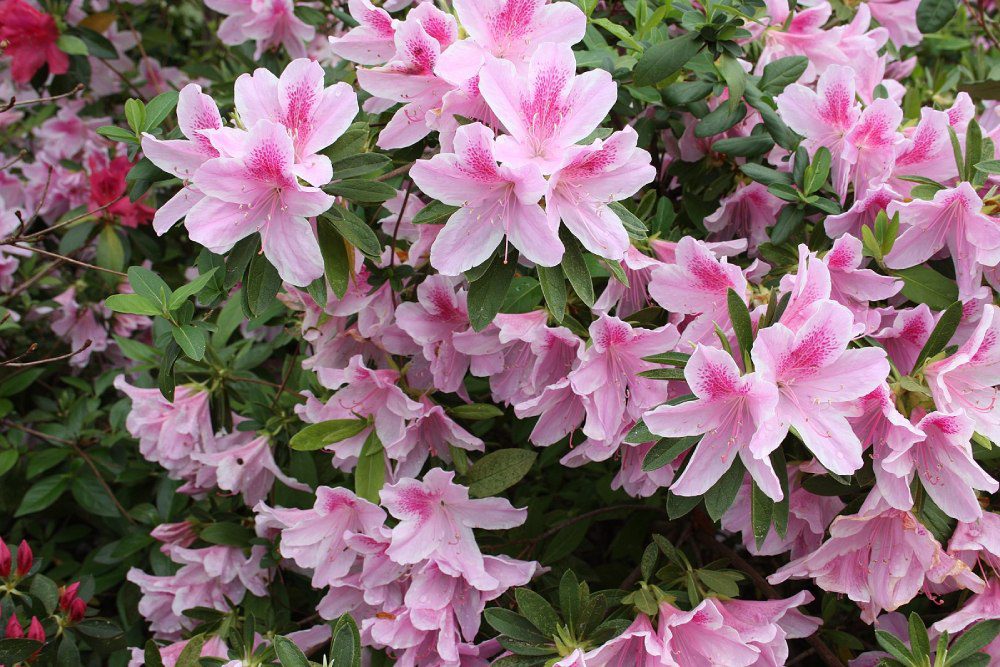
In Bloom: Late April to early May
Azaleas typically bloom from late April to early May in Japan, which is also the same period as the famous cherry blossom season. However, the peak blooming period may vary depending on the climate and location of the plants.
Meaning: Tsutsuji (躑躅) is the Japanese word for azalea, a flowering plant that is native to Asia and North America. In Japanese culture, the azalea is highly prized for its beauty and symbolism, and it is often associated with passion, femininity, and fragility.The azalea has a long history in Japanese art and literature, and it has practical uses in traditional Japanese medicine. Its meaning varies depending on its color; pink represents femininity and romance, red represents passion and intensity, and white represents purity and innocence. It is often given as a gift to express admiration or affection during special occasions such as weddings, graduations, and birthdays.
Where To See Them: Nezu Shrine in Tokyo, Kitano Tenmangu Shrine in Kyoto, and Hirado Castle in Nagasaki, Ashikaga Flower Park in Tochigi Prefecture and Tsutsuji-en in Kanagawa Prefecture
Azaleas can be found throughout Japan, from the northern island of Hokkaido to the southern island of Kyushu. Some of the most popular places to see azaleas include Nezu Shrine in Tokyo, Kitano Tenmangu Shrine in Kyoto, and Hirado Castle in Nagasaki. Other popular spots include Ashikaga Flower Park in Tochigi Prefecture and Tsutsuji-en in Kanagawa Prefecture.
Best Time To See Them: Late April or early May
The best time to see azaleas in bloom is typically in late April or early May, which is also the same period as the cherry blossom season. However, the blooming period may vary depending on the climate and location of the plants, so it’s always best to check with local tourism authorities for more accurate information.
Lotus (Hasu)
The lotus flower, known in Japanese as “hasu,” is a sacred and iconic flower in Japan. It has been admired for centuries for its delicate beauty, purity, and spiritual symbolism. The lotus flower grows in muddy water and emerges from the depths to bloom into a beautiful flower, making it a symbol of resilience and strength.
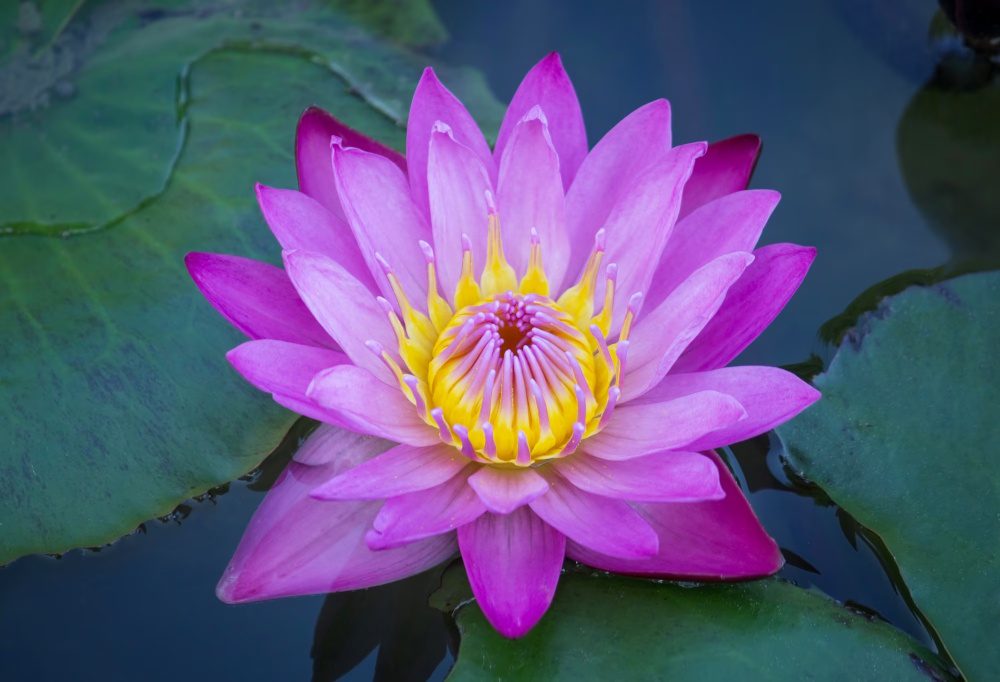
In Bloom: From June to August
Lotus flowers typically bloom in the summer months, usually from June to August, depending on the region and climate. They usually start blooming in the morning and close at night, so it’s best to plan your visit accordingly.
Meaning: The lotus, known as “hasu” (蓮) in Japanese, is a beautiful aquatic plant that has a significant cultural and religious importance in many Asian countries, including Japan. In Japanese culture, the lotus is associated with purity, enlightenment, and rebirth.
The lotus is a sacred flower in Buddhism, and it is often depicted in Japanese art and literature as a symbol of enlightenment and spiritual growth. In Japan, the lotus is also associated with summer and is a popular motif in traditional Japanese clothing, pottery, and architecture.
The lotus is also valued for its practical uses. Its roots, leaves, and seeds are used in traditional Japanese medicine to treat a variety of ailments, including diarrhea, fever, and inflammation.
In Japanese flower language, the lotus has a variety of meanings depending on its color. A white lotus represents purity and perfection, while a pink lotus represents devotion and love. A red lotus symbolizes compassion and purity of heart.
Where To See Them: Shinobazu Pond in Ueno Park, Hokoku Shrine in Kyoto, the Tsutsujigaoka Park in Sendai and the Onuma Quasi-National Park in Hokkaido
There are several places in Japan where you can see lotus flowers in bloom. One of the most popular is the Shinobazu Pond in Ueno Park, Tokyo. This park is home to over 800 lotus plants and attracts many visitors every year during the blooming season. Other notable places to see lotus flowers include the Hokoku Shrine in Kyoto, the Tsutsujigaoka Park in Sendai, and the Onuma Quasi-National Park in Hokkaido.
Best Time To See Them: From June to August
The best time to see lotus flowers in bloom is during the summer months, usually from June to August, depending on the region and climate. The exact timing of the bloom can vary slightly from year to year, so it’s best to check with the local tourism office or park officials for the latest updates. Early morning is usually the best time to visit to catch the flowers in full bloom and avoid the crowds.
Kiku (Chrysanthemum)
Kiku, or chrysanthemum, is a beautiful and iconic flower in Japan. It has been revered for centuries as a symbol of longevity, elegance, and grace, and is an essential part of Japanese culture and tradition. The flower’s unique shape and vibrant colors make it a favorite among locals and tourists alike.
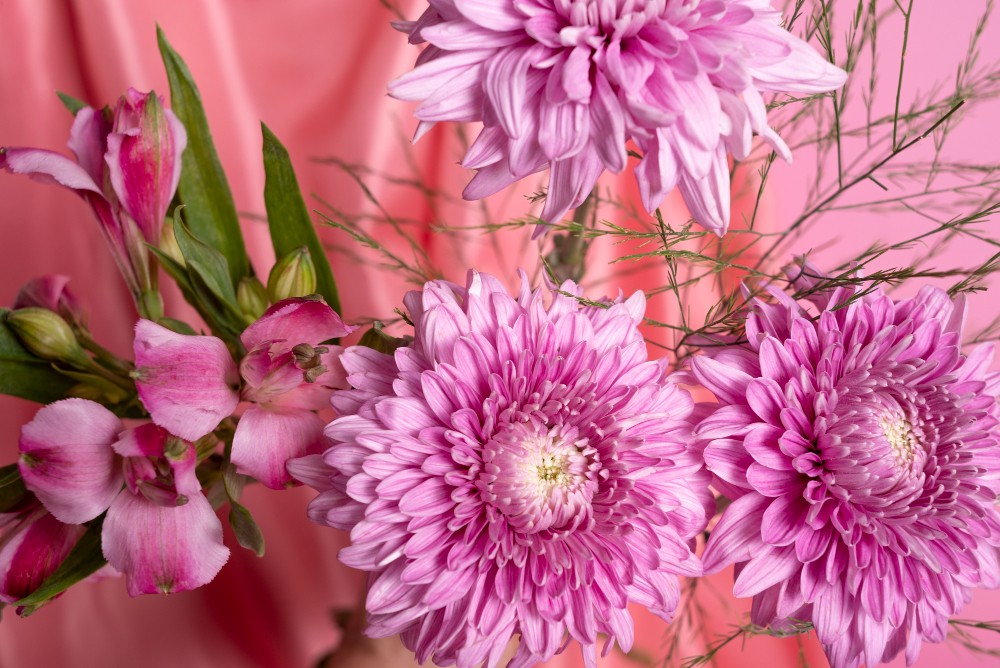
In Bloom: From September to November
The Kiku blooms in the fall, usually from September to November, and is a popular sight during the autumn season in Japan. During this time, various festivals and events are held throughout the country to celebrate the flower’s beauty and significance. The flower’s blooms range in color from white, pink, and red to yellow, orange, and even purple, creating a stunning and vibrant display. The petals are arranged in intricate layers, creating a unique and distinct shape that is instantly recognizable.
Meaning: Kiku is the Japanese word for chrysanthemum, a flower that has significant cultural and historical importance in Japan. It is the national flower of Japan and is associated with longevity, rejuvenation, loyalty, and the imperial family. The chrysanthemum has practical uses in traditional medicine and is also used as a symbol of love, passion, purity, innocence, and royalty depending on its color.
Where To See Them: Shinjuku Gyoen National Garden, Nabana no Sato flower park, Korakuen Garden in Okayama Prefecture, Kikusui Koen Park in Gunma Prefecture, Meiji Jingu Shrine, Shosenkyo Gorge in Yamanashi Prefecture
Kiku can be found in many places throughout Japan, but there are several locations that are particularly popular for viewing the flower in bloom. One of the most famous is the Shinjuku Gyoen National Garden in Tokyo, which boasts a vast collection of Kiku and other flowers. The garden hosts an annual Kiku Festival, which showcases thousands of blooming flowers in various shapes and sizes. Another popular spot is the Nabana no Sato flower park in Mie Prefecture, which features a stunning light display of Kiku blooms at night.
Other places to see Kiku in bloom include the Korakuen Garden in Okayama Prefecture, which has a dedicated Kiku Garden, and the Kikusui Koen Park in Gunma Prefecture, which features over 1,000 Kiku varieties. You can also find Kiku displays at various temples and shrines throughout Japan, such as the Meiji Jingu Shrine in Tokyo and the Shosenkyo Gorge in Yamanashi Prefecture.
Best Time To See Them: From September to November
As mentioned earlier, Kiku blooms in the fall, typically from September to November. The best time to see them varies depending on the location and weather conditions, but in general, mid-October is considered the peak season for Kiku viewing. This is when most of the flowers are in full bloom, and the colors are at their most vibrant. However, it’s worth noting that some Kiku varieties bloom earlier or later than others, so it’s a good idea to check with local tourism offices or websites for specific bloom times.
Sumire (Violet)
Sumire, or violet, is a charming and delicate flower that is cherished for its dainty beauty and sweet fragrance. It is a popular sight in Japan during the spring season when it blooms in various shades of purple, blue, and white, creating a stunning display of colors. In this article, we’ll take a closer look at Sumire and explore the best places to see them in bloom.
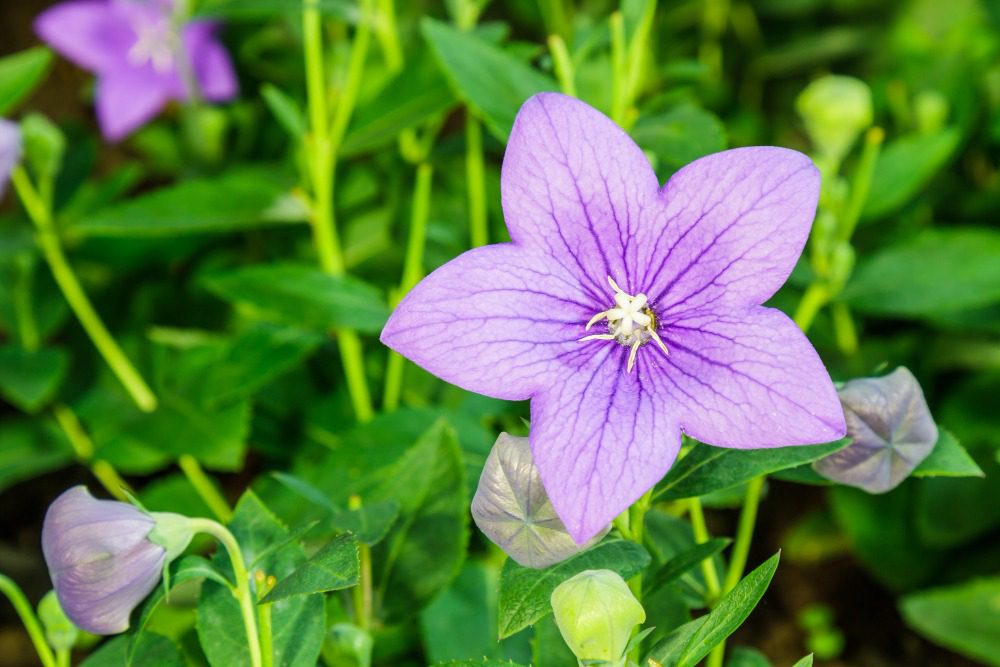
In Bloom: March to May
Sumire blooms in the spring, usually from March to May, and is a popular sight during the hanami season in Japan. During this time, locals and tourists alike flock to parks and gardens to admire the blooming flowers, including the Sumire. The flower’s sweet fragrance and delicate petals make it a favorite among flower enthusiasts and nature lovers. Sumire blooms range in color from pale lavender to deep purple, creating a beautiful and soothing sight.
Meaning: “Sumire” is a Japanese word that refers to a type of flower commonly known as “violet” in English. The word can also be written in kanji (Japanese characters) as “菫”. The flower is highly regarded in Japan for its delicate beauty and sweet fragrance, and it is a popular sight during the spring season when it blooms in various colors.
Where To See Them: Ashikaga Flower Park in Tochigi Prefecture, Hitachi Seaside Park in Ibaraki Prefecture, Shinjuku Gyoen National Garden in Tokyo, Kairakuen Garden in Mito City, Byodoin Temple in Kyoto and the Sanzen-in Temple in Shiga Prefecture
Sumire can be found in many places throughout Japan, but there are several locations that are particularly popular for viewing the flower in bloom. One of the most famous is the Ashikaga Flower Park in Tochigi Prefecture, which boasts a vast collection of Sumire and other spring flowers. The park hosts an annual “Wisteria and Sumire Festival,” which showcases thousands of blooming flowers in various shapes and sizes. Another popular spot is the Hitachi Seaside Park in Ibaraki Prefecture, which features a stunning display of Sumire blooms among other flowers.
Other places to see Sumire in bloom include the Shinjuku Gyoen National Garden in Tokyo, which has a dedicated Sumire Garden, and the Kairakuen Garden in Mito City, which features over 100,000 Sumire plants. You can also find Sumire displays at various temples and shrines throughout Japan, such as the Byodoin Temple in Kyoto and the Sanzen-in Temple in Shiga Prefecture.
Best Time To See Them: March to May
As mentioned earlier, Sumire blooms in the spring, typically from March to May. The best time to see them varies depending on the location and weather conditions, but in general, mid-April is considered the peak season for Sumire viewing. This is when most of the flowers are in full bloom, and the colors are at their most vibrant. However, it’s worth noting that some Sumire varieties bloom earlier or later than others, so it’s a good idea to check with local tourism offices or websites for specific bloom times.
Momo (Peach)
Momo, or peach, is a fruit that is loved for its juicy and sweet flavor, as well as its association with spring and summer. In Japan, Momo is not only enjoyed for its taste but is also appreciated for its cultural significance and beauty. In this article, we’ll take a closer look at Momo and explore the best places to see them in bloom.
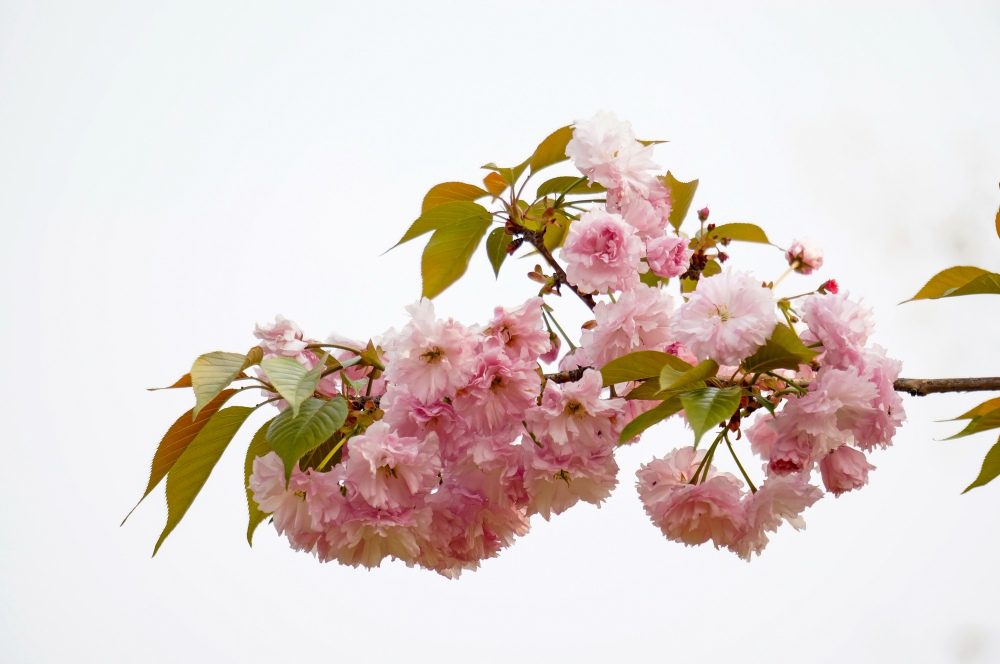
In Bloom: March to May
Momo trees bloom in the spring, usually from March to May, and their flowers are a popular sight during the hanami season in Japan. The flowers are delicate and fragrant, with soft pink petals that create a stunning display against the blue sky. Momo flowers are often used in traditional Japanese art, such as ukiyo-e woodblock prints, and they have become a symbol of spring and renewal in Japanese culture.
Meaning: In Japanese culture, Momo (桃) has a deep and significant meaning. The fruit is associated with longevity, good health, and happiness, and it is often used in traditional ceremonies and celebrations. Momo is also a symbol of love and romance, and it is believed that giving a Momo to someone you care about can bring them good luck and happiness.
Where To See Them: Kawazu-zakura Festival in Shizuoka Prefecture, Yamanashi Prefectural Fruit Park in Yamanashi Prefecture, Osaka Castle Park in Osaka, Himeji Castle in Hyogo Prefecture
Momo trees can be found in many places throughout Japan, but there are several locations that are particularly popular for viewing the flowers in bloom. One of the most famous is the Kawazu-zakura Festival in Shizuoka Prefecture, which features over 8,000 Momo trees in bloom. The festival takes place from early February to early March, and it attracts thousands of visitors every year.
Another popular spot is the Yamanashi Prefectural Fruit Park in Yamanashi Prefecture, which has over 300 Momo trees and a dedicated peach orchard. Visitors can enjoy a variety of peach-related activities, such as peach-picking and peach-themed cuisine.
Other places to see Momo trees in bloom include the Osaka Castle Park in Osaka, which has a dedicated Momo grove, and the Himeji Castle in Hyogo Prefecture, which is famous for its Momo trees that bloom in front of the castle.
Best Time To See Them: Early February to early March
As mentioned earlier, Momo trees bloom in the spring, typically from March to May. The best time to see them varies depending on the location and weather conditions, but in general, mid to late April is considered the peak season for Momo viewing. This is when most of the flowers are in full bloom, and the colors are at their most vibrant. However, it’s worth noting that some Momo varieties bloom earlier or later than others, so it’s a good idea to check with local tourism offices or websites for specific bloom times.
Bara (Roses)
Bara, known as “Roses”, are one of the most beloved flowers in the world, known for their sweet fragrance, stunning beauty, and cultural significance. In Japan, Bara has been cultivated for centuries, and it is a popular sight during the spring and summer seasons. In this article, we’ll take a closer look at Bara and explore the best places to see them in bloom.
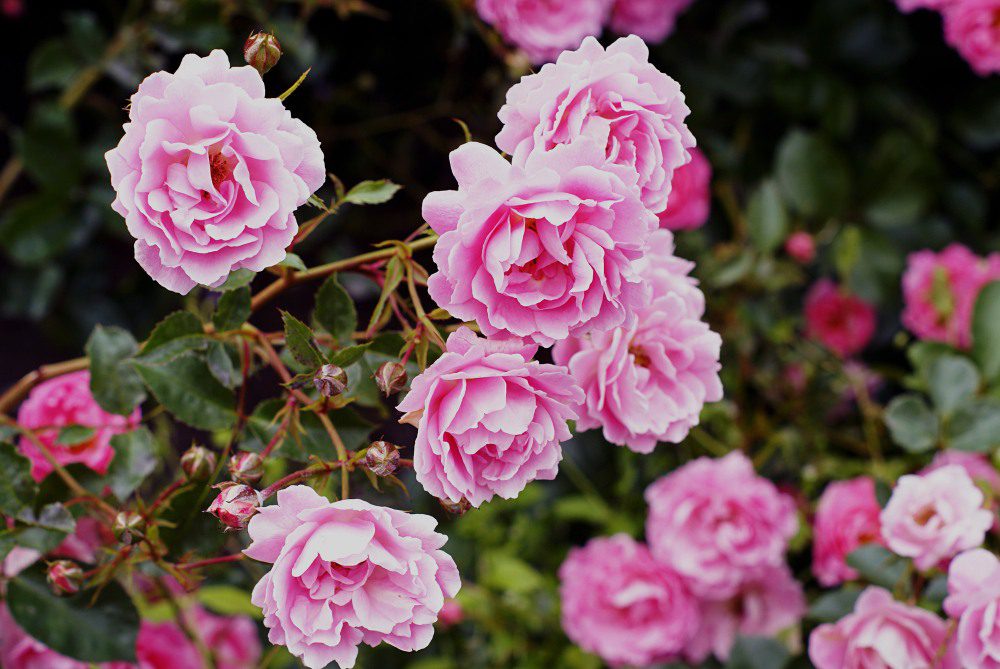
In Bloom: April to June
Bara trees bloom in the spring and summer, typically from April to June, and their flowers can range in color from soft pink to deep red. The flowers are known for their sweet fragrance and soft, velvety petals, which create a stunning display against the green foliage. Bara flowers are often used in traditional Japanese art, such as ikebana flower arrangements and tea ceremonies, and they are a symbol of love, passion, and beauty in Japanese culture.
Meaning: In Japanese culture, Bara (薔薇) has a deep and significant meaning. The flower is associated with love, passion, and devotion, and it is often given as a gift on special occasions, such as weddings and anniversaries. Bara is also a symbol of the transient nature of life, as its beauty is fleeting and ephemeral.
Where To See Them: Kairakuen Garden in Mito, Tokyo Metropolitan Park in Shinjuku, Shizuoka City Toro Museum in Shizuoka Prefecture, Hamamatsu Flower Park in Shizuoka Prefecture
Bara trees can be found in many places throughout Japan, but there are several locations that are particularly popular for viewing the flowers in bloom. One of the most famous is the Kairakuen Garden in Mito, which features over 3,000 Bara trees and is considered one of the three most beautiful gardens in Japan. The garden hosts an annual Bara Festival from late April to early May, which attracts thousands of visitors every year.
Another popular spot is the Rose Garden at the Tokyo Metropolitan Park in Shinjuku, which has over 2,000 Bara bushes of more than 400 varieties. Visitors can enjoy a variety of Bara-related activities, such as flower arranging and fragrance-making.
Other places to see Bara trees in bloom include the Shizuoka City Toro Museum in Shizuoka Prefecture, which has over 4,000 Bara trees, and the Hamamatsu Flower Park in Shizuoka Prefecture, which has a dedicated Bara garden.
Best Time To See Them: Mid to late May is considered the peak season for Bara viewing
As mentioned earlier, Bara trees bloom in the spring and summer, typically from April to June. The best time to see them varies depending on the location and weather conditions, but in general, mid to late May is considered the peak season for Bara viewing. This is when most of the flowers are in full bloom, and the colors are at their most vibrant.
Asagao (Morning Glory)
Asagao, also known as Morning Glory, is a charming and delicate flowering plant that holds a special place in Japanese culture. With its trumpet-shaped flowers in a range of colors, including blue, pink, purple, and white, it’s no wonder that it’s a beloved sight in gardens across Japan.
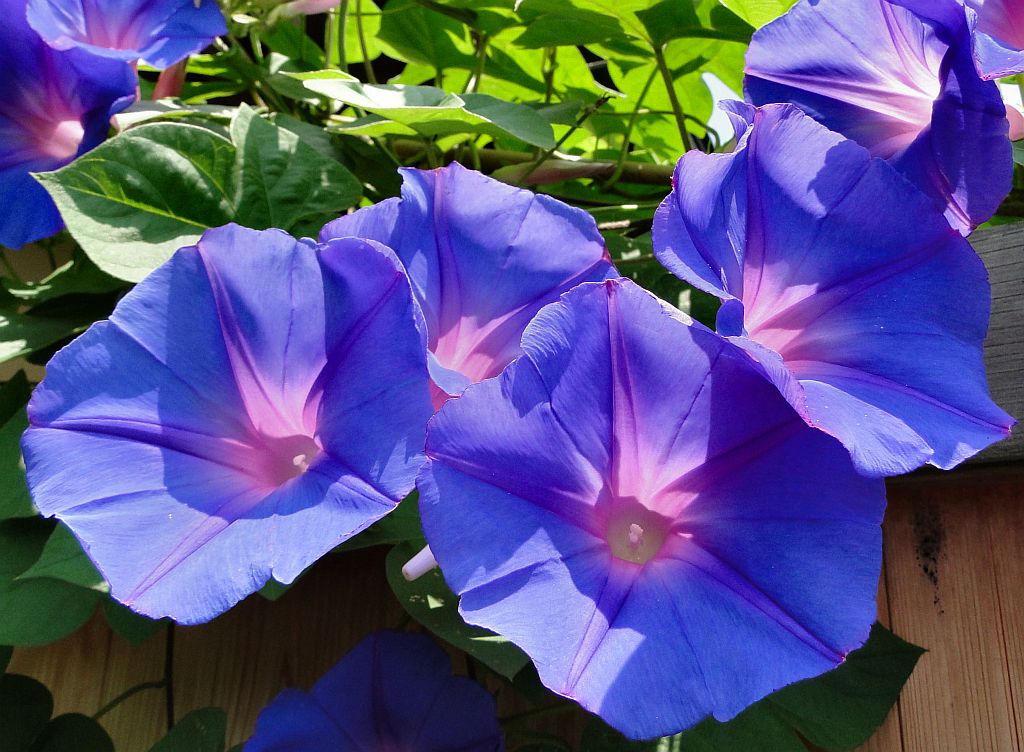
C: Rana Pipiens
In Bloom: July to September
The blooming of Morning Glory is a fleeting but beautiful sight to behold, with the flowers opening in the morning and closing in the evening. The plant blooms during the summer months, typically from July to September, making it a seasonal favorite.
Meaning: In Japanese culture, Asagao (朝顔) is a symbol of new beginnings and the start of a new day. The flowers open in the morning, representing the dawn of a new day, and close in the evening, symbolizing the end of the day and the passing of time.
Where To See Them: Morning Glory can be found growing in gardens, on trellises, and along fences throughout Japan. Some popular places to see them include Yushima Tenjin Shrine in Tokyo and the Asagao Koen Morning Glory Garden in Ibaraki.
Best Time To See Them: The best time to see Morning Glory in bloom is during the summer months when the plant is in full bloom. Visitors can enjoy the sight of the flowers opening in the morning and closing in the evening, creating a mesmerizing display of nature’s beauty.
Yuri (Lily)
Yuri, also known as Lily, is a captivating and elegant flowering plant that holds significant cultural and historical value in Japan. With its large, fragrant flowers in various colors, including white, pink, yellow, and red, it’s no wonder that it’s a popular sight in gardens and parks throughout Japan.
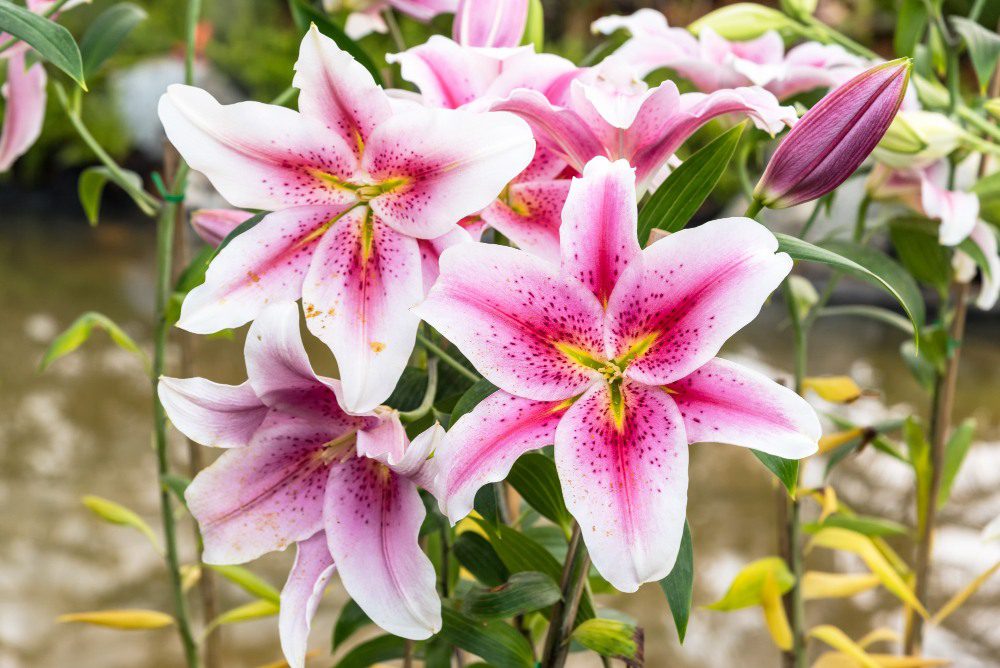
In Bloom: June to August
The blooming of Lily is a spectacular sight to behold, with the flowers opening in the early summer months from June to August. The plant’s tall stems hold the large flowers high, making it a striking addition to any garden or landscape.
Meaning: In Japanese culture, Yuri (百合) is a symbol of purity, renewal, and rebirth. It is often associated with the Buddhist teachings of enlightenment and the impermanence of life. Lilies are commonly used in various ceremonies, including weddings, funerals, and other special occasions.
Where To See Them: Lilies can be found growing in gardens, parks, and temples throughout Japan. Some popular places to see them include Hakone’s Venetian Glass Museum, Yushima Tenjin Shrine in Tokyo, and Yatsugatake Lily Garden in Nagano.
Best Time To See Them: The best time to see Lily in bloom is during the early summer months from June to August. Visitors can enjoy the sight of the tall stems holding up the large flowers in a variety of colors, creating a picturesque and serene display of nature’s beauty.
Kinmokusei (Orange Osmanthus)
Kinmokusei, or Orange Osmanthus, is a fragrant and colorful flowering plant that is highly valued in Japan for its aesthetic and aromatic qualities. With its distinctive orange flowers and sweet fragrance, Kinmokusei is a popular addition to gardens and parks throughout Japan.
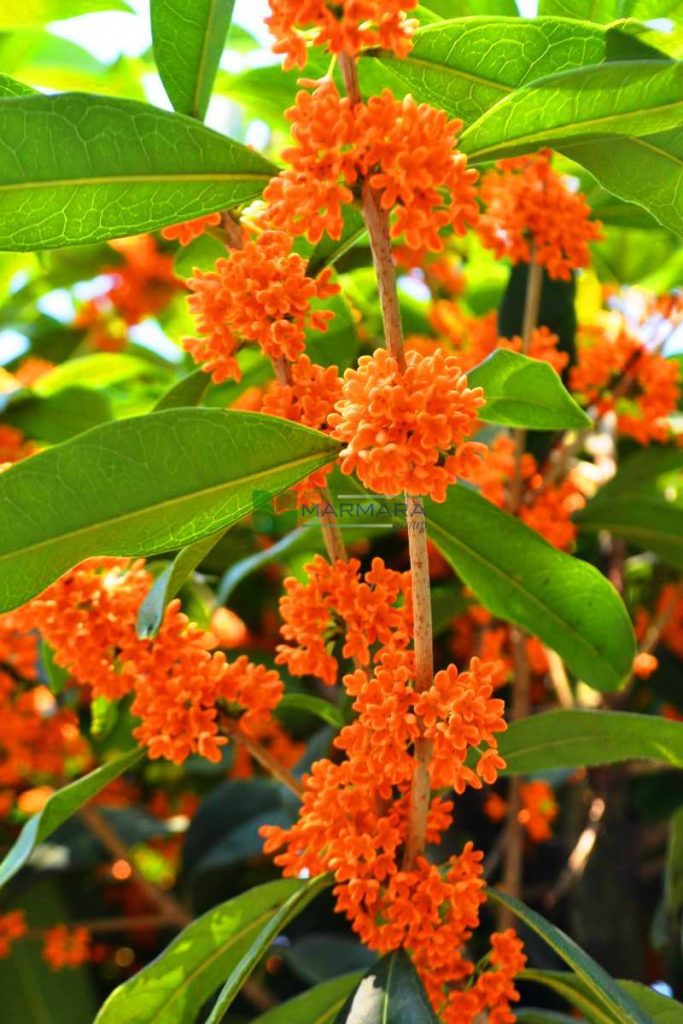
In Bloom: September to November
The Kinmokusei blooms in the autumn months from September to November, creating a vibrant and colorful display of orange and gold hues that add warmth and richness to the landscape. The plant’s small, delicate flowers grow in clusters, and their sweet aroma fills the air, creating a peaceful and serene atmosphere.
Meaning: In Japanese culture, Kinmokusei (金木犀) is a symbol of beauty, love, and devotion. It is often associated with the autumn season and is used in various celebrations and rituals. The flower’s sweet fragrance is believed to attract good fortune and positive energy, making it a popular choice for gardens and homes.
Where To See Them: Kinmokusei can be found growing in gardens, parks, and temples throughout Japan. Some popular places to see them include Koishikawa Korakuen Garden in Tokyo, Kairakuen Garden in Mito, and Dazaifu Tenmangu Shrine in Fukuoka.
Best Time To See Them: The best time to see Kinmokusei in bloom is during the autumn months from September to November. Visitors can enjoy the sight and fragrance of the plant’s delicate flowers in a variety of settings, creating a sensory experience that captures the essence of Japan’s natural beauty.
Kosumosu (Cosmos)
Kosumosu, or Cosmos in English, is a beautiful and popular flower that can be found throughout Japan. With its bright and colorful blooms, it’s no wonder why this flower has captured the hearts of so many. In this article, we will explore the beauty and significance of kosumosu, including when and where to see them.
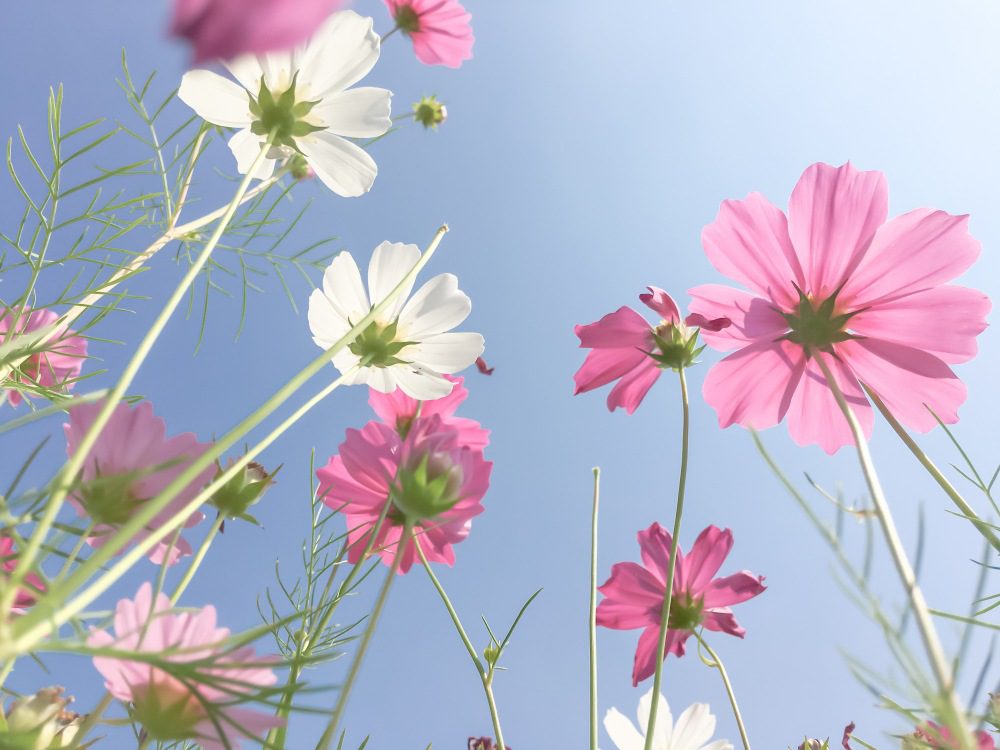
In Bloom: July to October
The vibrant and colorful cosmos flowers typically bloom in the late summer to early autumn months, from July to October in Japan. They are a common sight during the autumn season, adding a burst of color to gardens and landscapes.
Meaning: In Japanese culture, Kosumosu (宇宙) flowers represent peace and tranquility, making them a popular choice for gardens and landscapes. They are also believed to symbolize love and harmony, and their delicate petals are often used to represent the purity and innocence of children.
Where To See Them: Cosmos flowers can be found all over Japan, from parks and gardens to roadsides and fields. Some popular places to see cosmos include the Hitachi Seaside Park in Ibaraki Prefecture, Hamarikyu Gardens in Tokyo, and the Nabana no Sato flower park in Mie Prefecture.
Best Time To See Them: The best time to see cosmos in Japan is from late August to mid-November, with peak bloom times varying depending on the region. Visitors can expect to see a stunning display of pink, white, and crimson flowers during this time, making it the perfect season for flower viewing and photography.
 Spring Sale: 2 FOR 1
Spring Sale: 2 FOR 1 Croatia Sailing 2024: 2 For 1
Croatia Sailing 2024: 2 For 1 Greece Trips : 2 For 1
Greece Trips : 2 For 1  Central & Eastern Europe Tours: 2 For 1
Central & Eastern Europe Tours: 2 For 1  Why Travel Talk
Why Travel Talk Safe Travels with Travel Talk
Safe Travels with Travel Talk Fair Travels with Travel Talk
Fair Travels with Travel Talk Travel Talk Blog
Travel Talk Blog